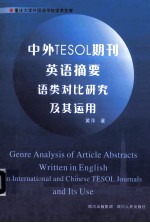图书介绍
中外TESOL期刊英语摘要语类对比研究及其运用PDF|Epub|txt|kindle电子书版本网盘下载

- 黄萍著 著
- 出版社: 成都:四川人民出版社
- ISBN:9787220075445
- 出版时间:2008
- 标注页数:433页
- 文件大小:52MB
- 文件页数:453页
- 主题词:中文-期刊-文摘-写作;英文-期刊-文摘-写作
PDF下载
下载说明
中外TESOL期刊英语摘要语类对比研究及其运用PDF格式电子书版下载
下载的文件为RAR压缩包。需要使用解压软件进行解压得到PDF格式图书。建议使用BT下载工具Free Download Manager进行下载,简称FDM(免费,没有广告,支持多平台)。本站资源全部打包为BT种子。所以需要使用专业的BT下载软件进行下载。如BitComet qBittorrent uTorrent等BT下载工具。迅雷目前由于本站不是热门资源。不推荐使用!后期资源热门了。安装了迅雷也可以迅雷进行下载!
(文件页数 要大于 标注页数,上中下等多册电子书除外)
注意:本站所有压缩包均有解压码: 点击下载压缩包解压工具
图书目录
Chapter 1 Introduction1
1.1 Preamble1
1.2 Research Focus3
1.3 Research Questions4
1.4 Rationale and Significance of This Study6
1.4.1 Theoretical Significance7
1.4.2 Practical Significance8
1.5 Thesis Overview8
Chapterr 2 Chinese Culture,Education and Writing Practices11
2.1 Introduction11
2.2 The Nature of Culture11
2.3 Chinese Cultural Influences on Chinese Education14
2.3.1 Chinese culture14
2.3.1.1 Authority15
2.3.1.2 Collectivism16
2.3.1.3 Chinese Essay Styles17
2.3.2 Chinese Education20
2.3.2.1 Primary School Education20
2.3.2.2 Middle School Education21
2.3.2.3 Higher Education22
2.3.2.4 Foreign Language Education23
2.3.2.5 The Teaching of English Writing27
2.4 Writing Practices in China29
2.4.1 Indirect Expression30
2.4.2 Exquisite Expression33
2.4.3 Chinese Characters35
2.4.4 Chinese Tradition36
2.4.5 Chinese vs.Western Writing Practices37
2.4.5.1 Respect vs.Plagiarism38
2.4.5.2 Inductivism vs.Deduetivism39
2.5 Chinese Academic Writing and Publication41
2.5.1 The Pressure of Publication42
2.5.2 Reluctance to Approach International Journals44
2.6 Conclusion45
Chapter 3 Journal Article Abstracts:Models for Analysis47
3.1 Introduction47
3.2 Discourse,Genre and Culture-A Close Relationship47
3.2.1 Genre Theory50
3.2.2 Genre and Culture52
3.2.3 Genre and Systemic Functional Linguistics53
3.3 Abstracts-A Distinct Genre in Academic Writing56
3.4 Genre variation59
3.5 Move Analysis-A Useful Tool61
3.5.1 Developing a Macro Model of Move Analysis64
3.5.2 Developing a Micro Model of Move Analysis68
3.5.2.1 Thematic Analysis69
3.5.2.2 Transitivity Analysis75
3.6 Macro and Micro Move Analysis-A Combination Model80
3.7 Conclusion81
Chapter 4 Research Methodology84
4.1 Introduction84
4.2 Theoretical Framework87
4.2.1 Mixed Methods87
4.2.1.1 Qualitative Procedures87
4.2.1.2 Quantitative Procedures89
4.2.1.3 Action Research(AR)89
4.2.2 Triangulation94
4.3 Research Management95
4.3.1 CFLCQU:The Research Site96
4.3.2 Research Processes99
4.3.3 Text Analysis100
4.3.3.1 Journal Article Abstracts(Part1)100
4.3.3.2 Participants'Assignments(Part3)103
4.3.4 Questionnaires(QN)104
4.3.4.1 QN 1 to CFLCQU Informants105
4.3.4.2 AR QN 1-4106
4.3.5 Semi-Structured Interviews106
4.3.5.1 CFLCQU Informants108
4.3.5.2 AR Group Interviews109
4.3.5.3 Interview Analysis110
4.4 Ethical Considerations111
4.5 Research Limitations112
4.6 Conclusion113
Chapter 5 Journal Article Abstracts Analysis114
5.1 Introduction114
5.1.1 Data Overview115
5.2 Macro Analysis117
5.2.1 The International Set119
5.2.2 The Chinese Set122
5.2.3 Comparative Analysis124
5.3 Micro Analysis133
5.3.1 The International Set134
5.3.1.1 Thematic Analysis135
5.3.1.2 Transitivity Analysis141
5.3.2 The Chinese Set146
5.3.2.1 Thematic Analysis148
5.3.2.2 Transitivity Analysis154
5.3.3 Comparative Analysis158
5.3.3.1 Distribution of Themes159
5.3.3.2 Thematic Progression161
5.3.3.3 Transitivity161
5.3.3.4 Lexis167
5.4 Conclusion172
Chapter 6 Interviews174
6.1 Introduction174
6.2 Interview Procedures175
6.2.1 Interview Informants176
6.2.2 Time and Site for Interviews180
6.3 Analysing the Interview Data180
6.3.1 Transcribing the Data181
6.3.2 Coding the Interview Data181
6.4 Data Findings185
6.4.1 Cultural Differences in Academic Writing185
6.4.1.1 Ways of Thinking186
6.4.1.2 Respecting Seniority190
6.4.2 Language Problems192
6.4.2.1 General Language Problems193
6.4.2.2 Appropriate Connectors193
6.4.2.3 Voice and Tense194
6.4.2.4 Lost Language/Chinglish195
6.4.3 Language Register196
6.4.3.1 Directness vs.Indirectness196
6.4.3.2 Chinese Typical Beginning197
6.4.3.3 Logical vs.Loose198
6.4.3.4 Plain Words vs.Beautiful Words199
6.4.4 Academic Writing Genre200
6.4.4.1 No Fixed Structure201
6.4.4.2 Main Idea or Summary203
6.4.4.3 Trivial Information First204
6.4.4.4 The Number of Moves205
6.4.4.5 Concise and Compact206
6.4.5 Experience in Publication207
6.4.5.1 Lack of Research Experience207
6.4.5.2 Lack of Reading Theoretical Books208
6.4.5.3 Lack of Good Relationship with Journal Editors210
6.4.5.4 Lack of Confidence in Submitting for Publication211
6.4.5.5 Lack of Information of Journal Requirements212
6.5 Conclusion212
Chapter 7 Action Research214
7.1 Introduction214
7.2 Procedure215
7.2.1 Stage 1-Planning(15,January-17,March)217
7.2.1.1 Initial Needs Analysis217
7.2.1.2 Course Goals240
7.2.1.3 Materials Selection and Development241
7.2.1.4 Lesson Design242
7.2.1.5 Summary248
7.2.2 Stage 2-Implementing(17,March-1,July)248
7.2.2.1 Teaching Each Lesson248
7.2.2.2 Classroom Discussions251
7.2.2.3 Teacher's Journal253
7.2.2.4 AR QN 3 for On-Going Course Assessment(see Appendix 7.5)254
7.2.2.5 Giving Assignments for Assessments263
7.2.2.6 Summary265
7.2.3 Stage 3-Analysing265
7.2.3.1 Analysing Participants'Assignments265
7.2.3.2 Analysing AR QN 2269
7.2.3.3 Analysing AR QN 4272
7.2.3.4 Analysing Case Studies279
7.2.3.5 Summary287
7.2.4 Stage 4-Reflecting289
7.2.4.1 Comparison of QN 1 to CFLCQU MA Students and Colleagues and AR QNS 1-4289
7.2.4.2 Comparison of Course Goals with Participants'Outcomes291
7.2.4.3 Interpreting the Group Interviews292
7.2.4.4 Interpreting the Analysis297
7.3 Conclusion298
Chapter 8 Discussion300
8.1 Introduction300
8.2 Cultural Influence302
8.2.1 Citation304
8.2.1.1 The Journal Article Abstract Analysis305
8.2.1.2 Informants'Views306
8.2.1.3 The Action Research Course307
8.2.2 Language Register308
8.2.2.1 The Journal Article Abstract Analysis308
8.2.2.2 The Interview Analysis308
8.2.2.3 Participants'Application of Language Register309
8.2.3 Language Genre310
8.2.3.1 The Journal Article Abstracts Analysis310
8.2.3.2 Informants'Viewpoints312
8.2.3.3 Participants'Use of Language Genre313
8.3 Inexperienee in Research314
8.3.1 Journal Article Abstract Analysis315
8.3.2 Interview Analysis319
8.3.3 The Action Research Course322
8.3.4 Summary327
8.4 Language Use328
8.4.1 Thematic Structure329
8.4.1.1 The Journal Article Abstract Analysis329
8.4.1.2 The Interview Analysis332
8.4.1.3 The Action Research Course332
8.4.2 Thematic Progression333
8.4.2.1 The Journal Article Abstract Analysis333
8.4.2.2 The Interview Analysis334
8.4.2.3 The Action Research Course334
8.4.3 Transitivity Structure335
8.4.3.1 The Journal Article Abstract Analysis335
8.4.3.2 The Interview Analysis336
8.4.3.3 The Action Research Course337
8.5 Summary337
8.6 Conclusion338
Chapter 9 Conclusion340
9.1 Introduction340
9.2 Implications340
9.2.1 Theoretical Implications340
9.2.2 Pedagogical Implications341
9.3 Recommendations342
9.3.1 A Teaching Model342
9.3.2 Developing an Academic Program343
9.3.2.1 Program Participants344
9.3.2.2 The Program344
9.3.2.3 Course Material345
9.3.2.4 Teaching Methodology345
9.3.3 Future Research346
9.3.3.1 More Corpora for Comparative Analysis of Academic Articles and Abstracts in International and Chinese Journals on TESOL347
9.3.3.2 More Research on Chinese TESOL Academics'Use of Themes and Transitivity348
9.3.3.3 More Interview Studies of Chinese Authors and Editors in Chinese TESOL Core Journals348
9.3.3.4 Expanding the Action Research Course to Other Aspects of Academic Article Writing348
9.4 Conclusion348
References350
List of Figures377
List of Tables379
List of Abbreviations385
Appendices①387
Appendix 4.1388
Appendix 4.2395
Appendix 4.3397
Appendix 4.4399
Appendix 4.5401
Appendix 4.6403
Appendix 4.7405
Appendix 6.1406
Appendix 7.1407
Appendix 7.2408
Appendix 7.3409
Appendix 7.4411
Appendix 7.5416
Appendix 7.6419
Appendix 7.7421
Appendix 7.8424
Appendix 8.1426
Appendix 9.1428
Acknowledgements431